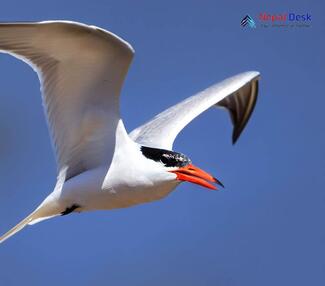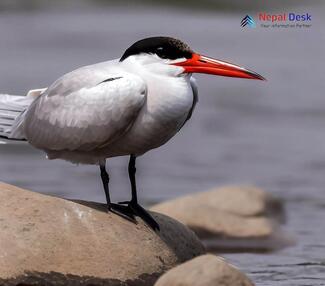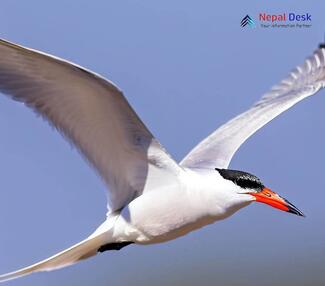Nestled amongst the breathtaking landscapes of Nepal lies a diverse and rich ecosystem that supports a wide array of bird species. One such magnificent bird that graces the Nepalese skies is the Caspian Tern (Hydroprogne caspia), a remarkable avian wonder known for its striking appearance and intriguing behavior. If you're an avid birdwatcher or simply curious about this captivating creature, join us as we delve into the world of the Caspian Tern in Nepal by knowing its various aspects described below:
Striking Features of the Caspian Tern
At first glance, you'll notice that the Caspian Tern boasts an impressive wingspan reaching up to 132 cm, making it one of the largest tern species worldwide. Its sharp, slightly curved bright red-orange bill and black cap offer a striking contrast to its pristine white plumage. When in flight, the translucent outer primaries create an awe-inspiring sight for onlookers.
Habitats and Distribution in Nepal
The Caspian Tern enjoys a broad global distribution, with populations scattered across coastal regions and inland water bodies. In Nepal, you'll find these sleek birds primarily near wetlands, lakes, reservoirs, and along riversides. Key bird sighting spots include the Koshi Tappu Wildlife Reserve, Chitwan National Park, and Phewa Lake.
Diet and Hunting Techniques
As skilled hunters with a penchant for fish, the Caspian Terns employ remarkable airborne techniques to locate and catch their prey. They meticulously scan the water surfaces from heights before rapidly diving toward their target with exceptional precision. While fish make up a majority of their diet, they've also been observed consuming crustaceans and small invertebrates.
Mating Habits and Nesting Sites
Caspian Terns exhibit monogamous behavior, forming long-lasting bonds with their partners. During the breeding season, from April to August in Nepal, they create simple nests on the ground, typically lined with some vegetation. These colonial nesters tend to lay 1 to 3 eggs per clutch and both parents play a vital role in incubating the eggs and raising the chicks.
Conservation and the Role of Birdwatching Tourism
Unfortunately, the Caspian Tern faces several challenges that threaten its population in Nepal. Habitat loss, human disturbances, and pollution pose risks to their breeding and feeding grounds. Conservation efforts are ongoing to protect these extraordinary birds.
Birdwatching tourism helps raise awareness about the need for conservation while also supporting the local economy in Nepal. As you embark on your journey to discover the enigmatic Caspian Tern in Nepal, you will not only experience an unforgettable adventure but also contribute towards preserving this impressive bird species for future generations. So grab your binoculars and set off on an expedition to uncover the magical world of the Caspian Tern in Nepal's natural utopia.




